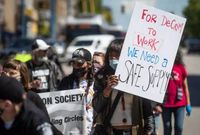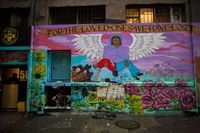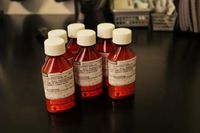After a devastating and record-breaking year for drug overdose deaths, the City of Vancouver formally submitted their proposal for the decriminalization of illicit drug possession to Health Canada on May 28, 2021. A step that has been long considered but never realized, drug decriminalization received public support from high levels of law enforcement and government in the past year, establishing a more supportive political climate. Vancouver’s decriminalization intentions also secured support from a variety of other stakeholders, including some civil society organizations, local Indigenous groups, and other British Columbia mayors. If accepted, Vancouver would receive a section 56.1 exemption from the Controlled Drugs and Substance Act (CDSA) which would permit individuals to possess drugs below specified levels in order to “promot[e] access to life-saving health services.” However, as the specific details of the “Vancouver model” emerged, activists and stakeholders did not hesitate to voice their concerns to the City. Accordingly, it is essential to evaluate the potential problems with the “Vancouver model” that critics have identified.
A primary denunciation amongst activists has been the disproportionate influence of the Vancouver Police Department (VPD) relative to other stakeholders on the drafting of the “Vancouver model.” While law enforcement would inevitably retain a significant role in decriminalization, and Health Canada requires police involvement in the drafting process, Canada’s history of policing people who use drugs (PWUD) gives cause for concern about the VPD’s role in formulating the City’s decriminalization plan. Furthermore, those who would be most impacted by the new policy, namely PWUD who split, share, and sell small amounts of drugs to survive, were inadequately consulted about the most significant components of the proposal.
By failing to consult the groups most directly affected, the new policy will produce knowledge gaps that fundamentally hinder the efficacy of decriminalization.
The “Vancouver model” has likewise been criticized for setting thresholds for what amounts of drugs constitute “personal use” far below what an average user has on any given day. Critics contend the current thresholds are rooted in outdated data, may promote the development of more dangerous, potent drug mixes, and would force people who use drugs to participate in the illicit drug market more often. Although Mayor Kennedy Stewart has stated that current levels are only “[a starting point](https://www.cbc.ca/news/canada/british-columbia/vancouver-decriminalization-model-flawed-national-coalition-says-1.6022310”, implying that they are dynamic and adjustable, raising thresholds in the future could be a significant political challenge and may hinder the overall effectiveness of decriminalization. It is worth noting that the thresholds of Portugal’s heralded drug policies are even lower than the levels proposed by Vancouver.
Moreover, like the Portuguese model, the “Vancouver model” would afford law enforcement “discretion” in charging individuals caught with amounts higher than the thresholds. Although this element has not emerged as a major issue in Portugal, Vancouver activists remain apprehensive about vesting police with these judgments, stating that PWUDs remain over-policed. Still, simple drug possession arrests by the VPD have consistently decreased in recent years and, relative to other BC police forces, Vancouver police have demonstrated more restraint in applying this charge. While individual officers may retain pro-prohibitionist views, the department as an institution has rhetorically supported decriminalization and drug policies that avoid charging people for possession. Nonetheless, until the entire department is brought into line, the mistrust will persist and undermine the City’s decriminalization efforts.
Beyond the issues raised by activists and critics, the funding details and treatment options outlined in Vancouver’s decriminalization plans leave much to be desired. As recognized by Dr. João Goulão, architect of Portugal’s current drug policy, decriminalization alone is not a panacea. It requires an extensive underlying treatment infrastructure, the sustainability of which can be precarious in the absence of dedicated funding. While detailed funding plans may be an unreasonable expectation at this stage, the City’s treatment options lack variety and inadequately address the root causes of drug dependency, despite aiming to reduce barriers and obstacles to treatment. By and large, the discussed treatment options are harm reduction policies meant to combat the existing toxic supply of drugs. Although this is undeniably essential in immediately reducing deaths, resolving the current drug poisoning crisis requires more than simply addressing drug use on a pharmacological level.
The “Vancouver model” must invest heavily in other, less traditional means of treatment, such as wage subsidies and psychological therapeutic support, that address the environmental elements of drug use dependence and enable PWUDs to participate and root themselves in society. Efforts such as the City’s partnership with Embers Eastside Works, which seeks to provide employment opportunities to those living on the Downtown Eastside, must be afforded greater funding, resources, and attention. However, Vancouver’s proposal mentions such programs only in passing. This leaves significant doubt regarding the City’s willingness to expand treatment options to become more eclectic and diverse. While these kinds of programs would inevitably require funding that is beyond the City’s budget, such as from the provincial and federal governments, it is discouraging that the proposed “Vancouver model” only scratches the surface in pushing for their implementation and expansion.
Evidently, the “Vancouver model” requires significant refinement.
Though Mayor Stewart suggests that there is only a narrow political opening to pass decriminalization legislation, poor implementation and planning may inadvertently exacerbate the current situation and become a calling card for those seeking a return to prohibitionist policies.
Given that a significant minority of Canadians maintain support for more punitive drug policies, the concerns surrounding the “Vancouver model” of decriminalization must be addressed and rectified. The current drug poisoning crisis clearly requires drastic action that generates immediate effects, but a superficial attempt at drug decriminalization would set back the struggle for more liberal, progressive drug policies and be an affront to activists who have fought tirelessly against the War on Drugs. More importantly, it would be an injustice to all those who unnecessarily suffered and died because of drug prohibition.
As it has been in the past, Vancouver is on the frontier of liberal, progressive drug policy and has an opportunity to transform how we approach drug use and drug dependence treatment. However, to emerge as a catalyst for new drug policy across the country, Vancouver’s decriminalization plans must involve all stakeholders, reflect the current circumstances, and include a more diverse and eclectic treatment infrastructure that addresses the root causes of drug dependence.




